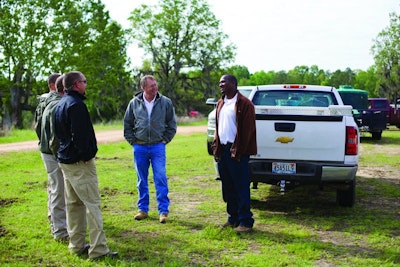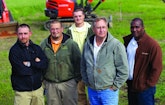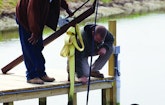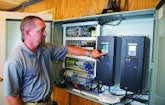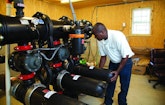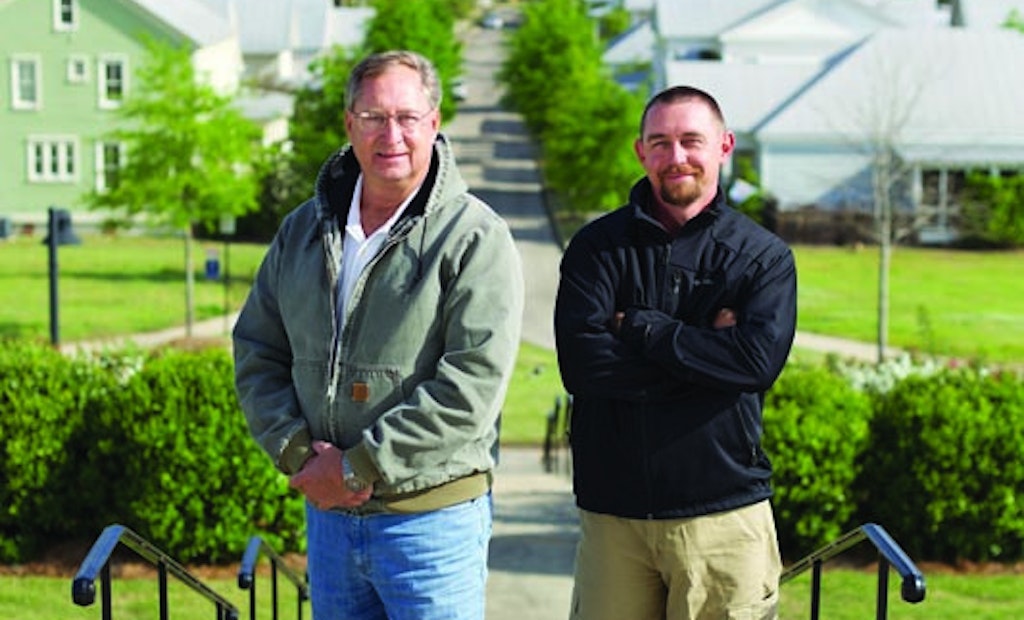
Interested in Excavating?
Get Excavating articles, news and videos right in your inbox! Sign up now.
Excavating + Get AlertsDanny Brown is planning for his third retirement by freely giving away his knowledge. Twice a successful entrepreneur, Brown credits his success to others who have shared their skills and abilities with him.
After retiring from a noteworthy career in the U.S. Navy, where he helped train an astronaut and a space shuttle flight commander, Brown began a new home construction business with his parents and his own family as the first customers. When he could not locate an onsite installer willing to meet his standards, Brown established his first onsite installation business.
“Shortly after retiring from the installation business, former customers approached me. They would not leave me alone. They all wanted me to continue working for them,” says Brown, 59. So he gave up on retirement and formed KESS Environmental Services in Lowdensboro, Ala. From his base 20 miles west of Montgomery and 100 miles south of Birmingham, he serves the entire state, covering a radius of about 400 miles.
PUSHING FOR QUALITY
Brown admits his profession doesn’t command the respect it deserves. “There is a stigma about working with the systems that manage a much-avoided material,” he explains. “The subject material does not make it OK to cut corners or reduce personal or regulatory standards. I will not lower my price or use inferior components to beat a competitor’s price.
“The regulations set the minimums; however, those minimums do not always meet my standards. For example, I will never use agricultural drainage tile – the black slotted corrugated flexible hose-like material – for distribution laterals.” Brown has encountered the corrugated material in the field, even though it deforms easily during backfill and makes maintaining a grade nearly impossible. Brown uses rigid SDR 35 pipe with 1/2-inch holes at five and seven o’clock.
Shortly after he got into the business, Brown met seasoned installer Dale Mask. “With nothing for him to gain, Dale mentored me. He helped me develop my professionalism and my skills.” Like Mask, Brown willingly mentors others in the business – he calls it a “nurturing process” that helps the entire industry.
“I have a responsibility to my industry to improve it by example and by giving away what I have learned,’’ he says, “and release these emerging onsite system professionals to continue their growth.”
And growth in professionalism means constant learning through coursework and licensing, he argues.
In the past few years, the regulation of installers in Alabama has become more structured. When regulations started, installers could be grandfathered into any of three license levels. The assumption has been that each higher designation is predicated on raised skill, knowledge and competency levels. But this wasn’t actually the case until current regulations went into effect.
“I pushed to require that training and continuing ed programs ensure that the holder of each higher certification brings an expanded set of demonstrated skills to the customer and his job site. This has not always been a popular stance among some installers,” Brown says.
ADVOCATING FOR NEW TECHNOLOGIES
Brown’s experience finding the right system to serve his parents’ new home taught him about limited options available to match a site’s soil characteristics to a system’s capabilities.
“My parents were faced with one option, a raised bed [mound] system which was not the best fit for their site.” For their particular soil, drip irrigation for effluent management was the best alternative. Eventually, working with county regulators and the Alabama Department of Public Health, Brown’s goal to obtain the county’s approval for drip irrigation was successful. However, this happened only after he installed a raised bed for his parents.
Not a fan of big pipe systems for large new-development neighborhoods, Brown eschews the inter-basin transfers, lack of groundwater recharge and high energy demands that accompany most of these systems. Instead, he prefers to keep the appropriately treated effluent close to its source through the use of drip irrigation as the final stage in the treatment cycle.
“We are installing systems that are designed to eventually serve as many as 2,500 homes,’’ he says. That works out to a 2 million gpd design flow. “Yes, we deliver an effluent clean enough for stream discharge, but we prefer the immediate benefits of ground water recharge,” he explains.
BIG-SYSTEM SPECIALTY
Brown’s typical big system is not typical in all regions nationwide. Sometimes called a community system, they employ a blend of components owned by both property owners and utilities. These systems can serve townhouses or detached single-family homes, provided each owner has title to sufficient land to contain a solids-separation tank in close proximity to the building. The homeowner owns and has responsibility for interior plumbing and the sewer running to the tank. Beyond that connection, a utility has ownership and maintenance responsibilities.
The customer for these big systems is a corporation sanctioned by the Alabama Public Service Commission. This for-profit corporation performs like a utility in all regards, except the label. These community systems are designed by the customer’s engineer and approved by the appropriate environmental regulator.
“The tanks we install were designed by our customer and incorporate a proprietary effluent filter,’’ he explains. “This standardization ensures that the owners and service providers have a small and universally applicable set of repair parts to stock and use.
“The client’s designers do their best to let gravity move as much of the effluent as possible through smaller-diameter pipes that are typically 36 to 48 inches below the surface,” says Brown. If there is not enough relief, pumps are used to move the solids-free liquid.
Treatment methods for the collected liquid vary, influenced by built-out design flow, local soil situations and available space. For really big systems, the designers prefer dual stage lagoons or – as they are called in some areas – waste stabilization ponds. These shallow, man-made impoundments provide passive secondary treatment.
Secondary treatment for fewer than 100 homes is typically achieved through fine aggregate filters that utilize No. 57 or No. 67 washed river-rock-sourced aggregate.
WORKS GREAT. WHO PAYS?
Regardless of the secondary treatment process, the resulting effluent is reintroduced to the soil through 1-inch-diameter Netafim drip irrigation tubing. While the drip field soils dictate linear loading rates, a typical drip zone has about 50,000 linear feet of tubing installed on 5-foot centers.
In addition to groundwater recharge areas, drip fields provide perpetual open space that adds an aesthetic component to the community, a positive benefit that fits Brown’s outlook on natural resource management. “The system that will eventually process 2 million gpd will contribute about 250 acres of green space,” he says.
The large onsite treatment systems Brown installs are often described as innovative and alternate solutions. Likewise, system ownership and maintenance/management, while atypical, are gaining popularity. Not one of the systems KESS has installed has been financed with public dollars or is owned or managed by a governmental unit.
Infrastructure funding is an up-front developer or builder obligation. These costs are recovered through home sales. When completed, each section’s infrastructure is handed off to a government-regulated utility for long-term operation, maintenance and management. The utility bills the homeowner for services delivered.
“These innovative solutions define the niches in which we have found a comfortable and profitable working environment,” Brown says.
SKILLED HELP, PROFESSIONAL OUTLOOK
Talented KESS employees are cross-trained for maximum contribution to the company’s success, Brown says.
“We are all equipment operators who have gained that distinction by learning and demonstrating our skills in real job site conditions.” Brown says he doesn’t need to be on site to know the tasks will be handled to his standards.
“Jonathan Larkin, some may say, is over-qualified to install systems because he holds two degrees from Auburn University,” says Brown. A forester and horticulturalist with a Level 1 installer’s credential, Larkin is set to succeed Brown in an ownership role when the latter retires for the third time. He is the owner in training. The rest of the crew includes crew leader Sears Smith, Matthew Gray and the newest hire, James Cothron.
KESS is a Clearstream and Norweco distributor. That role brings Brown into contact with countless potentially competing installers. “My mentor, Dale Mask, is a Delta distributor. When we met, he saw me as a colleague he could help. That is how I see my so-called competitors too.”
Educating employees, subcontractors, suppliers, regulators and customers is essential in Brown’s view. No one is immune to or excluded from his drive to bring professionalism and understanding to the industry as a whole.
These approaches illustrate Brown’s personal higher standards and philosophies: Simply meeting the regulations is not good enough. Selling products but not fostering professional growth is not good enough. Brown sums it up this way, “My industry deserves the best I can deliver.”
MORE INFORMATION
Clearstream Wastewater Systems, Inc. - 800/586-3656 - www.clearstreamsystems.com
Delta Environmental Products - 800/219-9183 - www.deltaenvironmental.com
Ditch Witch - 800/654-6481 - www.ditchwitch.com
Kubota Tractor Corporation - 310/370-3370 - www.kubota.com
Netafim USA - 888/638-2346 - www.netafimusa.com
Norweco, Inc. - 800/667-9326 - www.norweco.com
